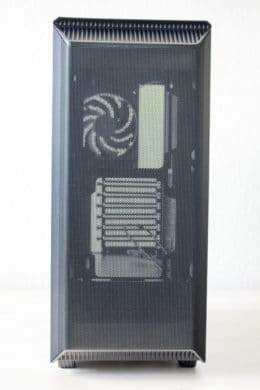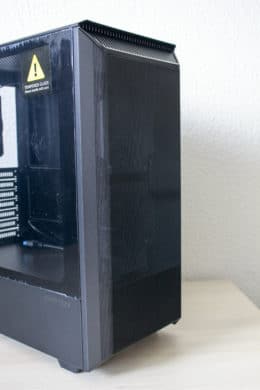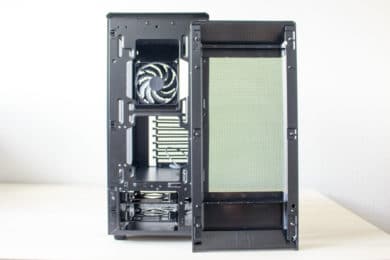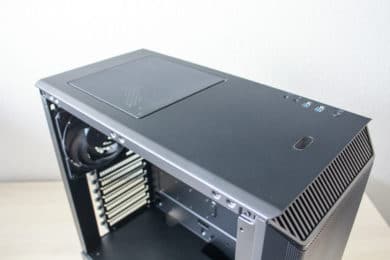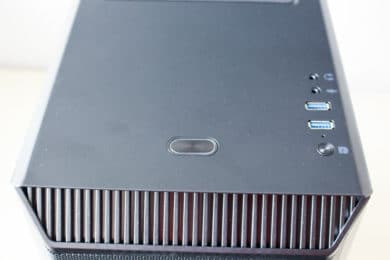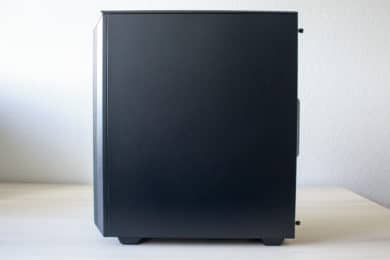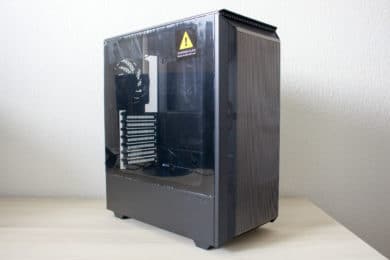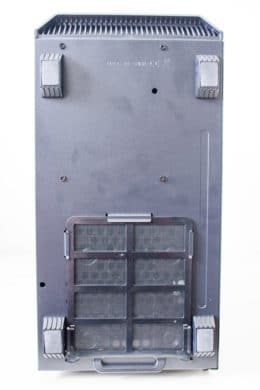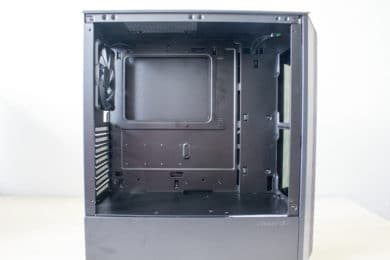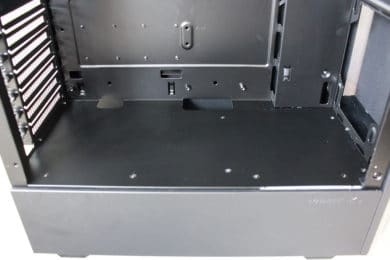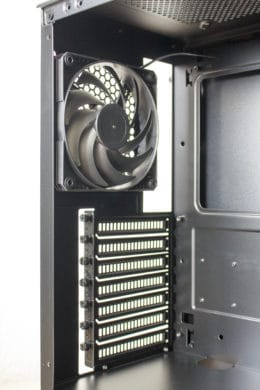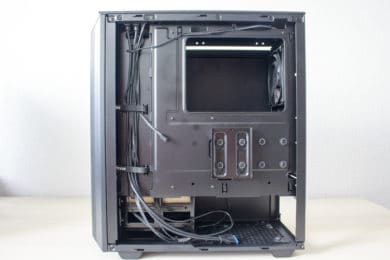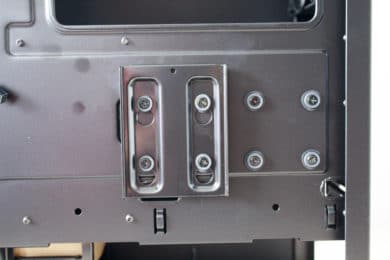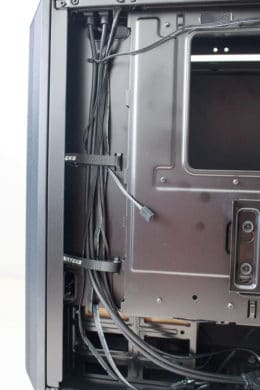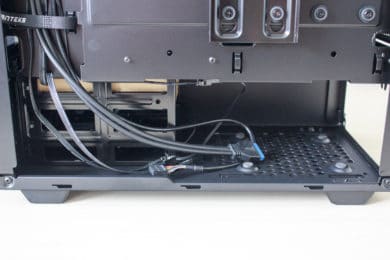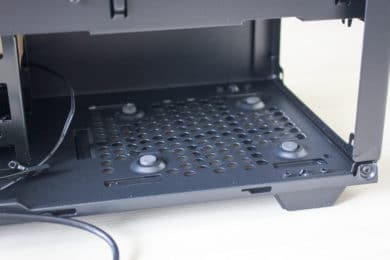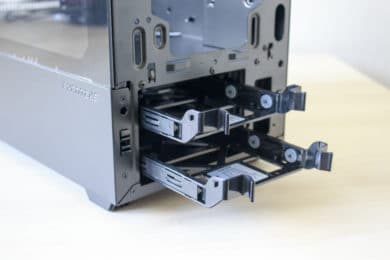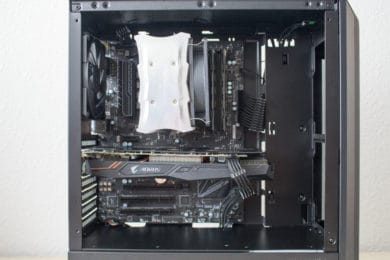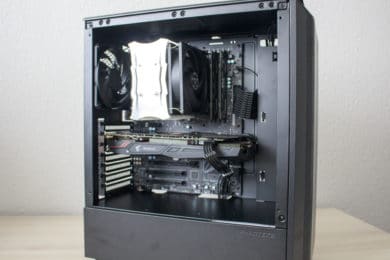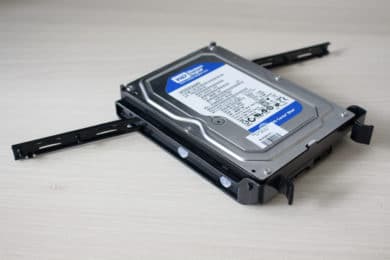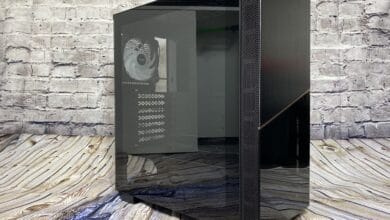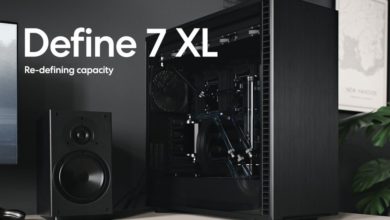
About two and a half years ago, the Dutch manufacturer Phanteks introduced the Eclipse P300, a cheap but well-equipped midi tower. The P300 has done many things right. But due to the closed front, the original version sometimes had problems with the temperatures. At the CES 2020 Phanteks then officially introduced a new version to address the airflow problem. This version is aptly named Eclipse P300 Air and differs from the original version in only one point: the front panel is completely made of mesh.
The Eclipse P300 Air is only available in a black version and costs € 80.90 . In the following review we take a closer look at the Phanteks Eclipse P300 Air and tell you if it’s worth buying this midi tower.
Technical details
| Model: | Eclipse P300 Air |
| Case type: | Midi Tower |
| Dimensions: | 200 mm (W) x 455 mm (H) x 400 mm (D) |
| Weight: | approx. 6 kg |
| Material: | steel, plastic, tempered glass |
| Color: | black |
| Front connectors: | 2x USB 3.0 Type-A, 1x speaker, 1x microphone |
| Drive bays: | 2x 3,5″/ 2,5″ (internal) 1x 2,5″ (internal) |
| Extension slots: | 7x horizontal |
| Form factors: | ATX, mATX, mini-ITX |
| Ventilation: | front: 2x 120 mm or 2x 140 mm Rear: 1x 120 mm Cover: 1x 120 mm or 1x 140 mm |
| Radiators: | front: 1x 280 / 240 mm Rear: 1x 120 mm |
| Max. CPU cooler height: | 165 mm |
| Max. graphic card length: | 355 mm |
| Max. Power supply unit length: | 200 mm |
| Place for cable management: | 16 – 34 mm |
| Place for front radializer: | max. 110 mm |
| Price: | € 80.90 |
| Features | dust filter, cable management, glass side panel |


Scope of delivery
The Phanteks Eclipse P300 Air comes well and safely packed in a brown box with black writing and is wrapped in normal styrofoam blocks. On the carton you can only see pictures of the product, basic technical data is unfortunately not available here. To reduce the risk of scratches, the manufacturer has also covered the side window with an additional protective film. The included accessories are located in a brown box inside the hard disk cage. It contains all the important screws, a user manual, six black cable ties and a warranty manual. The scope of delivery also includes a pre-installed 120 millimeter fan, pre-installed spacers, as well as dust filters for the cover and power supply.
External impression
The exterior design of the Eclipse P300 Air can be described as simple and hardly differs from the original P300. The only difference is directly noticeable when looking at the front. It is not closed, but consists entirely of a finely structured mesh. The striking ventilation grilles in the upper and lower part of the front panel, on the other hand, have been closed. There is also no additional dust protection behind the mesh. If you remove the front, which is attached with metal lugs, two mounting locations for two 120 or 140 millimeter fans and the hard disk cage, which is aligned to the front, come to light.
The lid of the P300 Air has been designed for convenience. In the front area you will find the power button in the middle and the I/O panel on the side. This has two USB 3.0 ports, two ports for headphones or microphone and a reset button. In the rear area of the lid section there is an additional fan opening for a fan with a frame width of 120 or 140 millimeters. To protect it from dust, this opening has also been fitted with a magnetic dust filter.
The left side panel is made of tempered glass and is not tinted. It should also be mentioned that the glass window does not cover the entire left side. The lower part is made of steel and belongs to the body and not to the side panel. The right side is completely made of steel and has sufficient stability. Both side panels are fastened with knurled screws and have practical recessed grips. A nice feature is also that the knurled screws remain on the side panels after disassembly and thus cannot be lost.
On the back or underside there is standard equipment. The power supply unit is mounted below and above it there are seven PCI slot panels. In addition, there is space for a pre-installed 120 millimeter fan and the opening for the I/O shield at the rear. The P300 Air stands on four solid plastic feet and has an easily removable dust filter for the power supply.
Internal impression
The interior of the Phanteks Eclipse P300 Air is classically designed for today’s standards and has been divided into two different areas by a power supply cover. The power supply and the HDD cage for two 3.5″ or 2.5″ hard drives are hidden under this cover. To facilitate the laying of cables, there are two cable management openings in the power supply cover. Otherwise the tunnel is completely closed and does not allow a view of the lower area. A feature we only noticed after switching on the installed system is a white LED strip above the Phanteks logo. It shines easily through the side panel but cannot be changed in color.
Above the cover there is space for the mainboard and expansion cards as usual. Due to the compact dimensions of this midi tower there is not infinite space and only normal width ATX mainboards can be installed. Around the mainboard tray there are, besides the already mentioned ones, seven more openings for the cable management. The right outputs are not parallel to the tray but angled at 90 degrees. In the front area there is enough space to install a 240 or 280 millimeter radiator. Due to the absence of hard drive cages, fans mounted there can transport fresh air into the interior unhindered.
The seven PCI slot bezels are all reusable, have ventilation slots and are all fixed outside the case with practical thumb screws. It should also be mentioned at this point that there are no disturbing steel struts between the slot covers.
Let’s now take a look at the back. Here you’ll find various holding points for cable ties and a decoupled frame for 2.5″ HDDs or SSDs. In addition, a second HDD frame, which is not included in the scope of delivery, could be mounted on the back. A cable management cable has been inserted in the left area and the completely black I/O cables have been pre-installed. Phanteks used two practical Velcro strips for this purpose.
In the zone underneath the cover, the power supply unit fits on four round rubber buffers. Next to it, the manufacturer has fixed the hard disk cage. But this was attached in an unusual position. Compared to other manufacturers, the HDD slides are removed to the front and not to the side. If you don’t want to install a HDD, you can also remove the cage completely. To do this, you only have to remove six screws with a screwdriver.
The external and internal finish and stability are good. There are no paint defects or sharp edges where you could cut yourself. There is nothing to complain about for a case in this price range.
System construction in the Phanteks Eclipse P300 Air
Now we come to the system installation. As hardware we use a AMD Ryzen 7 2700X* on a MSI B350 PC Mate with 16GB Crucial Ballistix Sport LT grey DDR4-2666. The Ryzen is cooled by an EKL Alpenföhn Matterhorn Pure. For the image output is a GTX 1060 6GB from Gigabte AORUS responsible. The power supply does the non-modular Berlin Pro RGB 650W with RGB fan. In order to improve the cabling optically a little bit, single sleeved cable extensions of Phanteks were used.
The installation of all components in the Eclipse P300 Air was easy and fast. Thanks to the well-positioned and dimensioned cable management openings and the good space behind the mainboard tray, all cables could be laid neatly. The final result is definitely presentable. The remaining space conditions are also good. A maximum of 165 millimeters of space is available for CPU coolers. This is sufficient for almost all powerful air coolers. Even with a maximum possible length of 355 millimeters for graphic cards or 200 millimeters for the power supply, the buyer hardly has to think about it when choosing his components. However, the maximum length for the power supply only applies when the HDD cage is removed.
In the case of the 2.5″ HDD, a screwdriver is required to mount the data carriers on the frame. However, the HDD tray can then be attached to the mainboard slide without tools. The large 3.5″ hard disks, on the other hand, can be mounted completely without tools. To do this, the lateral brackets on the frame are opened, the HDD is inserted and finally the brackets are closed again. The connections then also point to the front. Fortunately, the manufacturer has also thought of a corresponding opening to make wiring easier.
The pre-installed case fan has a frame width of 120 millimetres and rotates at a maximum of 1400 revolutions per minute. It is connected via a black 3-pin connector that can be plugged directly onto the mainboard. At full speed the fans are unfortunately well audible. Reduced to 800-900 revolutions per minute, the noise is much more pleasant, but the flow rate is noticeably lower.
Finally, we come to the temperatures reached in the Eclipse P300 Air. During the load test, Prime95 and FurMark were run for 15 minutes at a room temperature of 20 °C. Additionally, this test was carried out in two different variants (case fan to 100%, case fan to 50%).
Scenario |
Temperature |
| CPU: 50% PWM (1100 rpm) GPU: 50% PWM (1650 rpm) Housing: 100% (1400 rpm) |
CPU: 73 °C GPU: 65 °C |
| CPU: 50% (1100 rpm) GPU: 50% PWM (1650 rpm) Housing: 50% (900 rpm) |
CPU: 78 °C GPU: 67 °C |
Ex factory, the Phanteks P300 Air achieves only average temperature results with the one pre-installed fan. The processor is only slightly overclocked, the GPU is completely on standard clock. If you are planning an even more powerful system in the P300 Air, then you should buy at least two more fans for the front. Otherwise, the mesh front doesn’t really use much.
Conclusion on the Phanteks Eclipse P300 Air
Let us now come to the final conclusion of this review. The Phanteks Eclipse P300 Air is a sensible improvement on the original version of this midi tower. The use of the mesh front noticeably increases the airflow when you invest in additional fans. Other good features, such as the basic solid workmanship, the interior space and compatibility with AiO water cooling systems make the P300 Air a potential candidate for budget and mid-range gaming PCs.
However, the potential improvement in airflow also comes with a drawback. Of course, the mesh front makes it easier for sounds from the interior to escape to the outside. Additionally, the absence of a dust filter in the front probably increases the cleaning effort and the buyer has to do without any RGB effects ex factory. If you include the price of € 80.90 , this midi tower actually offers everything you would wish for a solid “gaming case”. But the bigger problem is the competition.
The choice is huge and the Phanteks P300 Air can’t really stand out.
But if you’re looking for a solid midi tower that can accommodate and cool a normal gaming system, the P300 Air does nothing wrong. Additional front fans should be considered in any case.
Phanteks Eclipse P300 Air
Workmanship
Structure
Features
Cooling
Value for money
85/100
Solidly equipped and spacious midi tower with good airflow potential and a justified price.





